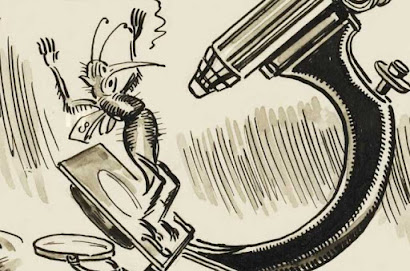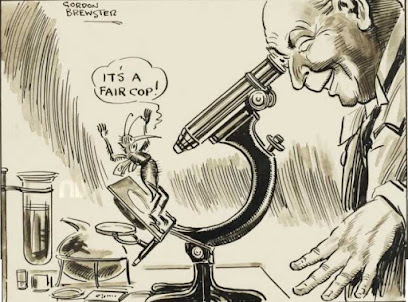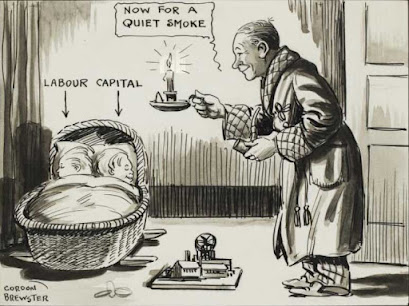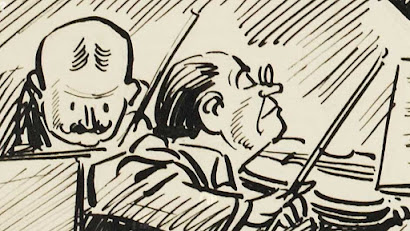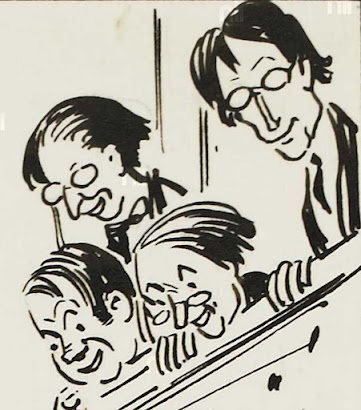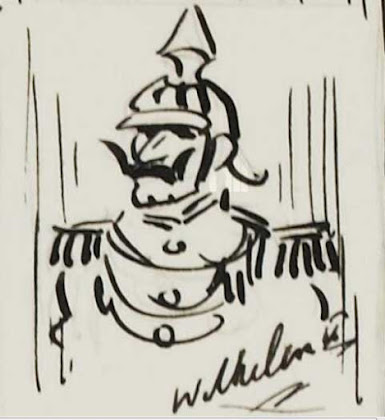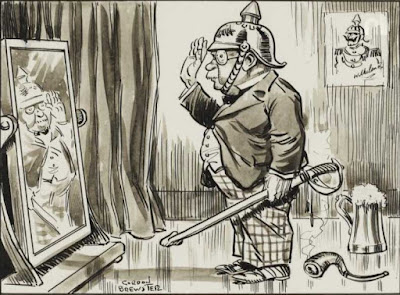Sunday, September 27, 2020
GORDON BREWSTER AND DETAIL
One of the characteristics of Brewster's cartoons that fascinates and amuses me is his attention to detail. It is not always needed to the degree he puts it into the cartoons, but there is some little obsession of the perfectionist there, or is he sometime making a particular comment or having a little joke?
This post could end up a mile long, but I am confining myself to just a few examples. I think you'll get the message.
There is a huge amount of detail in the flu virus above, although, to be fair, it takes up a significant portion of the overall picture, below.
This is clearly a coal mine, but as you'll see below it is only an insignificant portion of the full cartoon.
The cartoon refers to the UK 1926 miners strike.
This is one of my favourite details. Is that a smirk or just plain rapture on the fiddler's face?
Maybe why I like it so much is that I used to play in a pit orchestra and compared to being onstage it was always great fun.
I can't leave this one without pointing out that the context is the Imperial Economic Conference of 1932, a meeting at Ottawa intended to devise new arrangements for intra-imperial trade; Britain was keen to keep or gain privileged access to empire markets, but it was reluctant to meet the desire of empire countries. Anyone for Brexit?
Incidentally it was the last Imperial Conference that any Irish government participated in. Our rep was Seán T O'Kelly, described in the attendance list as Vice President (which he was of the Executive Council at the time).
This detail is quite a significant proportion of the full cartoon, but what catches my attention here is that the people are representations of real personalities of the day. I'm not great at identifying them but I think I see Yeats, Lennox Robinson, and one, if not two, of the Sheils brothers
You might be tempted to comment here that this is a rather sloppy image of the Kaiser, but when you see it is just a small picture on the wall in the full cartoon, you might change your mind.
Note the detail in the mirror.
I am not concerned here with the content of this cartoon which is a turf war between the Corpo and the Port Authority on who is responsible for safety on Dollymount strand.
Rather, my attention was drawn to the Martello Tower (No.1 Dublin North) towards the top left of the picture.
Here you can see it in a little more detail. And would you not be glad to put that on your wall as it is. And, just in passing, it is no accident that it is there. Brewster knew his Martello Towers well.
Saturday, September 26, 2020
HAPPY BIRTHDAY GORDON
Gordon Brewster, artist and cartoonist, was born on this day in 1899 at 15 Dolier Street in a building that was later to become part of the offices of the Irish Times.
He was trained as an artist at the Metropolitan and he exhibited in the Royal Hibernian Academy in 1916 and 1917. He kept up his painting throughout his life but I have only been able to come up with one example of his fine art.
We are unfortunate to have been deprived of the bulk of his work through fire: first in the destruction of the Royal Hibernian Academy during the 1916 Rising and then through the destruction of what remained after his death by his estranged wife in a bonefire in the back garden of The Grove, where he lived in Sutton.
He died suddenly on Bloomsday, 16 June 1946, in the Gem, my mother's shop, in Howth.
Fortunately his day job turned out to be chief cartoonist for Independent Newspapers and he has left us a collection of some 500 of his original cartoons which have been acquired by the National Library of Ireland and have now been digitised.
I have to record here my appreciation of the library staff, specifically Honora Faul who was responsible for the collection and who gave me access to it pre-digitisation, and Carol Maddock who invited me to do a post on them for the library's own blog.
In acknowledging Gordon's birthday, I thought I'd assemble a series of links to posts I have done on some of the themes that run through the cartoon collection. The collection, between 1922 and 1932, covers only a portion of his cartoon output and the themes reflect this.
Despite the limited period represented in the collection, much of his work remains timeless, and I am currently enjoying playing SNAP on Twitter: when a cartoon by someone else appears I dredge up a Brewster cartoon in response.
I hope you will take time to peruse some of these posts and come to the same conclusion as myself that we are dealing here with a serious artist whose output is informed and nuanced, but not lacking in fun.
Enjoy.
Gordon Brewster - Timeless
Gordon Brewster and the Flu
Gordon Brewster and the 1916 Rising
Gordon Brewster and Censorship
Gordon Brewster and Northern Ireland
Gordon Brewster and Sport
Gordon Brewster and The Grove
Gordon Brewster and Our Oil
Gordon Brewster and the General Election
Gordon Brewster and Gender Equality
Gordon Brewster and the Man on the Bridge
Gordon Brewster and his Martellos
Gordon Brewster and Detail
Gordon Brewster on the Radio
Sunday, September 13, 2020
CROWDFUNDING THE REVOLUTION
I have always been amazed by the Counter State during the Irish War of Independence. The rebels set up a whole alternative state machinery which ran very efficiently under the noses of the British occupying forces.
The various aspects of this counter state gradually got the support of the people and, after the 1920 local elections, of the country's local authorities.
It was a cat and mouse game for those running it. The British had enormous advantages: a large trained military force, a paramilitary police force, control of the country's financial system, and so on.
It was not plain sailing for the rebels. They suffered loads of setbacks but persisted in the face of adversity. There were confiscations, deaths, and many close shaves. But the system kept working, defying the logic of the times.
The only restraint on the British was their international reputation. That was all that held them back from unleashing the full forces at their disposal. After all they couldn't be seen to be like the Germans when turning up at the Paris post-WWI peace conference. And they couldn't afford to alienate the USA which was very tuned in to what was going on in Ireland through its large Irish immigrant population. And after the savage British reaction to the 1916 rebellion, the British press was keeping its eyes peeled for any further savagery on the part of the administration. The rebels fully exploited these constraints
One of the most daring and amazingly successful acts of the counter state was the launch of the Dáil loan. This was promoted both and home and abroad in the United States. It brought in loads of cash and this was the cash that was moved around the country and hidden in plain sight in various accounts in the conventional banking system.
This is the crowdfunding referred to in the title of this admirable book which documents the trials and travails of the loan. It is a fascinating story and one which, although known in part, has not been documented in its entirety and put across in a book as riveting and entertaining as this. The author, Pat O'Sullivan Greene, has been following this up for a while now and he had access, inter alia, to the papers of Daithí Ó Donnchadha, who was secretary to the loan trustees and whom the author describes as Michael Collins's right hand man in financial matters.
The author gives us a glimpse of Daithí in his man about town disguise:
In his early forties, he had been appointed secretary to the trustees of the loan. In this role, he would become the chief launderer of the proceeds of the loan, often carrying thousands of pounds on his person from the clearing houses around the city.The British eventually decided to pull out all the stops and attack the loan through the various accounts in which it was stashed. Alan Bell, head of British Intelligence in the city, became the Grand Inquisitor, as he serially summonned various relevant bank managers and grilled them under oath. The bankers were put to the pin of their collective collar to avoid revealing all and Collins realised that the funds were under real threat at this point. So he had Bell shot and that dealt with that for the moment.
Working closely with Michael Collins, he put systems and processes in place to record, control and safeguard the proceeds of the loan. Bank accounts were opened using fictitious names, or the names of ‘trusted friends’. He was responsible for recording the amounts subscribed and the issue of official receipts.
Source
After Independence the small matter of repaying the loan arose. When the loan was launched, probably few of the contributors ever expected to see their money back but now an independent Irish Government moved to repay the loan. The Free States Courts in 1925 released relevant funds to the Free State Government, which would then go on to repay the domestic element of the loan.
However, complications arose at the United States end where the de Valera faction claimed ownership of the funds. I'll let John Horgan take up the story from here:
De Valera was not slow to turn his new power and position to advantage in other ways, and now moved to put the final piece in place in a complicated jigsaw begun several years earlier. In 1919—21, Irish emigrants in the United States had subscribed funds for bonds to be redeemed by an independent Irish government. A large amount of money was collected and lodged in a US bank, but, after the Civil War, a dispute arose between de Valera (who had been involved in the fundraising) and the Free State government as to who owned the money. In 1927, the US supreme court decided that it belonged to neither, and ordered that the money be returned to the original subscribers.[Some of us will remember another £100,000 which split the Fianna Fáil party in 1970, but that is, of course, another story entirely.]
In 1930, de Valera wrote to those subscribers, asking them to transfer their right to be reimbursed to him, so that he could launch a national Irish newspaper. Many did so. Now in government, he moved financial legislation to repay all the American lenders — those who had transferred their rights to him as well as those who had not — with a premium, effectively returning $1.25 for every dollar they had lent. The funds for this operation came from the Irish exchequer, which his party now controlled. Despite parliamentary accusations that de Valera was ‘looting the public purse for a party organ (DD, 5 July 1933), the measure was passed: £1.5 million was paid to the bondholders, £100,000 of which found its way directly back to the Irish Press on the basis of the transfers signed three years earlier.
Source
In the course of the War of Independence the Sinn Féin Bank had been replaced by the Land Bank which was then the bank of the revolution. After independence the Bank of Ireland became the Government's Banker and swallowed up the Land Bank in 1926 as depicted in Gordon Brewster's cartoon, above.
Meanwhile, with the Exchequer repaying the Dáil Bond Loan it had its own need of cash, and in 1927 it launched its own loan. Brewster's take on this is shown above.
Personal resonances:
The book evoked a number of personal resonances for me.
Uimhir 6
Number 6 Harcourt Street was the headquarters of the Sinn Féin Bank. It is now the site of the headquarters of Conradh na Gaeilge, the Irish language bookshop, and An Club. I spent a fair whack of time in the last of these, where the pint was cheap and, as long as you spoke only in Irish, you would not be thrown out until the early hours of the morning or when the cloud of cigarette smoke descended sufficiently low from the ceiling to threaten your senses.
Uncle Mick
My family tell me that my uncle used to be a runner for the other Mick (Collins) in London. I have no way of verifying this. The uncle did work in London around that time until the granny sent the eldest brother over to bring him home lest he be conscripted into WWI.
This is the uncle I had understood to have fought with Dev in Bolands Mills (Bakery) and whose record of this I couldn't trace. I found out later that he had actually been a flour salesman for the bakery. I wasn't entirely surprised as I never remember him expresssing any nationalist sentiments in the time I knew him.
Daithí Ó Donnchadha
I never knew Daithí, but I have had a lot of contact with his grandson, Niall, who has restored a Martello Tower in Killiney
Cathal Brugha Barracks
I spent a whole day, a while back, at an event in the barracks dealing with the Birth of the Counter State. It was a fantastic day and I learned a lot. You might like to click on the link above and check it out.
The Book
Just to remind you that we have been talking about Pat O'Sullivan Greene's book Crowdfunding the Revolution. A great read and another contribution to the Decade of Centenaries.
Subscribe to:
Posts (Atom)
